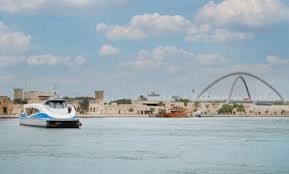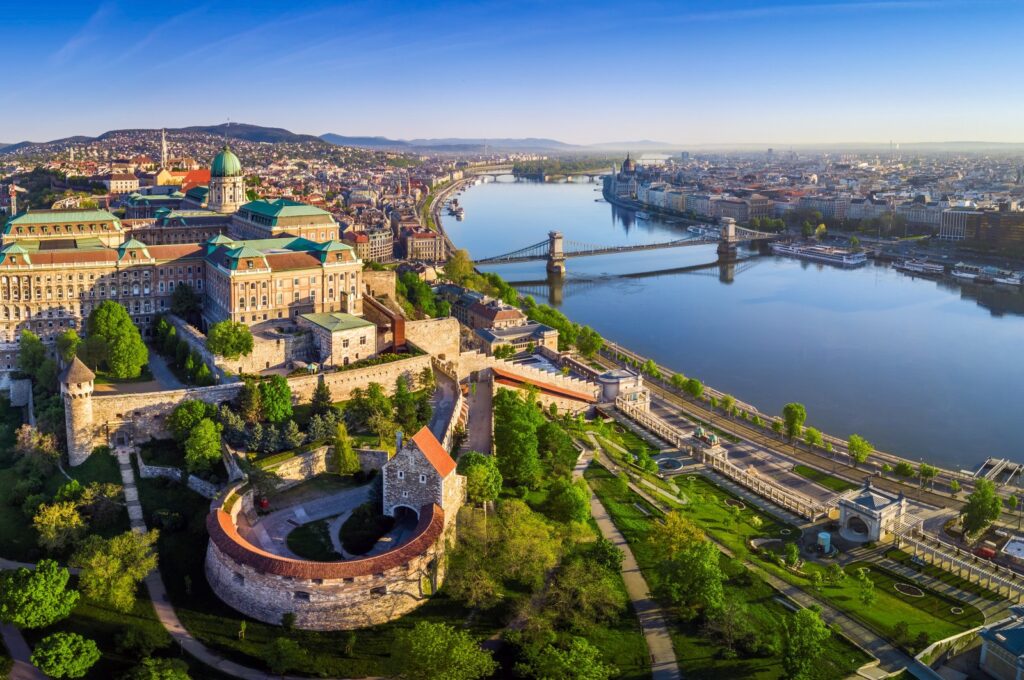
Chrissie McClatchie
As the snow-capped peaks of the Maritime Alps faded into the distance behind me, I followed my guide Maddy Polomeni further along a corridor of golden mimosa blossoms as we hiked towards an abandoned quarry in the Massif de l’Esterel mountain range. Although it was the latter end of the flowering season, there was still an abundance of blooms along this trail, unlike many of the other mimosa circuits higher up in the peaks behind us.
The correct term for each bud is glomerulus, but “pom-poms”, as Polomeni calls them, felt a more fitting name for the fluffy, featherlight balls that filled the late February air with the sweet aroma of marzipan.
“I feel like spring is already here,” she said.
These rocky ranges behind Mandelieu-La Napoule, the coastal town west of Cannes in southern France, are home to Europe’s largest mimosa forest. For six years, Polomeni has been one of the few registered guides leading small groups along walking trails that criss-cross this dry Mediterranean landscape. Along the way, she’s become a point of reference for travellers like me who are following La Route du Mimosa, a 130km road trip that starts in Bormes-les-Mimosas, 35km west of Saint-Tropez, and finishes in the perfume-scented town of Grasse in the Cannes hinterland, an itinerary best travelled between January and March when the region breaks out in giant brushstrokes of rich yellow.
Known as wattle in its native south-eastern Australia, mimosa was introduced to the French Riviera by British aristocrats who flocked to its resort towns in search of winter sunshine. Making its first appearance around 1880, the Acacia dealbata (or silver wattle) they brought in their luggage quickly took to the acidic soils of the French region’s mountainous western terrain. “Having found the same growing conditions as back in Australia, the plant spread,” horticulturist Julien Cavatore told me.
Pépinières Cavatore, his family nursery in Bormes-les-Mimosas, stocks more than 180 species of the plant; it has been recognised as one of the country’s finest collections by the Conservatoire des Collections Végétales Spécialisées (a French association modelled on Britain’s Plant Heritage).
“One of the things I love most about mimosa is that it blooms during a period of the year when you don’t get any other flowers,” Cavatore said.
The Route du Mimosa was created in 2002 along existing secondary roads, and while I was surprised to find that it isn’t obviously signposted, a brochure is available in local tourist offices (and online) that serves as a guide to the various waypoints and activities. Cavatore said that people often ask why there are not “huge forests of mimosa” as they head off from Bormes-les-Mimosas – in fact, for much of the early stages of the drive, the landscape is the dusty greens and winter browns typical of the season. As he explained, however, the route is more about a theme, a showcase of eight towns and villages that have each developed cultural ties to a plant that has become a symbol of winter on the French Riviera.

Maddy Polomeni is one of the few registered guides leading small groups along walking trails of La Route du Mimosa (Credit: Chrissie McClatchie)
From shady Bormes-les-Mimosas, where French presidents have vacationed since Charles de Gaulle first visited in 1968, the route starts along the coastal D559, a two-lane road heavy with holidaymakers in search of clean air and sandy beaches in summer but which, at this time of the year, flows freely.
Bypassing Saint-Tropez for Sainte-Maxime (its low-key but charming neighbour across the bay), the D559 continues past pétanque courts and waterfront restaurants towards the popular resort town of Saint-Raphaël. The 30km stretch between Saint-Raphaël and Mandelieu-La Napoule, where majestic red ochre rocks tumble into the sparkling Mediterranean Sea below, is one to savour: known as the Corniche d’Or, the road mimics the twists and turns of the craggy coastline before opening out onto the Bay of Cannes.
Mandelieu-La Napoule is the self-styled mimosa capital – since 1931 it has played host to La Fête du Mimosa, a 10-day programme of parades and street entertainment held each February. Although the 2022 event was cancelled due to the pandemic, the town is still the perfect stop for an exquisite mimosa-infused pause. In the waterfront neighbourhood of La Napoule, Mathieu Marchand, executive pastry chef at Riviera institution L’Oasis, first drew inspiration from the colourful blooms surrounding his kitchen last year, creating a mimosa-flavoured macaron that became a menu mainstay during the 2021 flowering period.
This year, he’s added a delicate cake to the seasonal selection. “Starting with a cheesecake base, I’ve placed a caramelised peanut inside and finished with a white chocolate ganache,” he said. Less than 2g of the distilled flower essence is used in each individual pastry, yet the bitter-almond and orange-blossom flavours of mimosa are distinct. “Next year, another creation that shows the many possibilities of mimosa will be unveiled,” he promised.

Mathieu Marchand, executive pastry chef at Riviera institution L’Oasis, created a mimosa-flavoured macaron (Credit: Chrissie McClatchie)
The array of artisanal products that highlight the plant’s attributes as a culinary ingredient is steadily increasing. In Mandelieu-La Napoule’s tourist office, a display of locally made mimosa products includes chocolates, honey and even a vodka-based liquor called Mimocello.
However, the profession of mimosistes – or the people who cultivate mimosa – is at risk of disappearing. At the start of the 20th Century, there were 80 growers working out of Le Capitou, Mandelieu’s oldest neighbourhood. In the 1920s, whole railroad cars of cut mimosa would leave Cannes and La Napoule for flower markets as far away as Moscow and London, the precious blooms placed protectively inside baskets woven from cane and willow, an entire artform in themselves. Today, only a handful of mimosistes remain, mostly growing the flowers in the land around the Massif du Tanneron, the mountain range between Mandelieu, Tanneron and Pégomas known as the ‘Golden Triangle’ of mimosa.
In a quiet cul-de-sac in Pégomas, a village dating from the 16th Century just inland from Mandelieu, I found Cécile Reynaud at La Colline des Mimosas, her family’s horticultural business. She was busy wrapping bouquets laden with freshly cut branches for a steady stream of passing customers. Reynaud is a third-generation mimosiste: her grandmother first planted mimosa to sell to perfumeries in the 1930s. Today, their market is cut flowers, supplying more than 100,000 bouquets a year to a mix of individuals and professionals, as well as seasonal festivals. “I’m so infused in mimosa that during the season I stop being able to smell it,” she said.
Mimosistes like Reynaud are masters of their art, their ability to manipulate the plant developed over a lifetime of harvests. Nowhere is this more evident than in the forcerie – a temperature-controlled room where branches of yet-to-open buds are “forced” into flowering in hot, humid conditions, for anywhere between six and 36 hours. The technique extends both the life of the cut flowers by up to 10 days and the growing season. The talent of the mimosiste is knowing exactly how long to leave the flowers in the forcerie – “if we leave it too long, there is a point of no return and the flowers fade,” she said.

Cécile Reynaud is a third-generation mimosiste: her grandmother first planted mimosa to sell to perfumeries in the 1930s (Credit: Chrissie McClatchie)
From Pégomas, I drove the short distance through residential neighbourhoods towards Grasse and the rose, iris and jasmine gardens that supply perfume houses like Chanel and Dior with their raw product. Much of the mimosa currently found in perfumery is synthetic, since its pom-poms are so lightweight that the quantity required to extract enough essence is considered too labour-intensive to use its true form. But there are hopeful signs this is changing: Reynaud was preparing for a visit the next day from a “grand nez” – a perfumer recognised for their ability to compose scents.
“Now that Grasse’s perfume-making techniques have Unesco World Heritage status, there’s an increased demand for the area’s other flora,” she said.
Should that be the case, then Grasse’s place as the final stop on this floral route is set to acquire an even greater significance. From start to finish, La Route du Mimosa can easily be covered in a day, but two days (the average time most people take, Polomeni told me) is better. Anything more is a bonus, because the real delights of this southern French road trip are found off the main roads and outside of the car – in the forests, greenhouses and kitchens where these tiny rays of winter sunshine have firmly taken root.
Courtesy: bbc
The post France’s 130km Mimosa Route appeared first on The Frontier Post.








